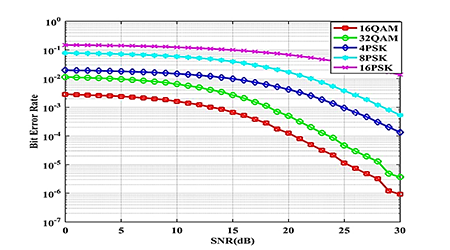


Indian Journal of Science and Technology
DOI: 10.17485/IJST/v13i42.2027
Year: 2020, Volume: 13, Issue: 42, Pages: 4374-4385
Original Article
K Chidananda Murthy1∗, Mahalinga V Mandi2 , R Murali3
1 Research Scholar, Department of Electronics and Communication Engineering, Dr. Ambedkar Institute of Technology, Bangalore, Karnataka, India
2 Professor, Department of Electronics and Communication Engineering, Dr. Ambedkar Institute of Technology, Bangalore, Karnataka, India
3 Professor, Department of Mathematics, Dr. Ambedkar Institute of Technology, Bangalore, Karnataka, India
Corresponding author:
[email protected]
Received Date:08 November 2020, Accepted Date:30 November 2020, Published Date:04 December 2020
Background/Objectives: Wireless communication systems are growing towards the implementation of 5G communication systems to satisfy the demand of services in future. OFDMA has some shortcoming like one or more subcarriers of OFDM are completely affected due to the characteristic of the transmission channel. Spreading scheme has been introduced to combat the aforementioned issue. Furthermore, communication channels are affected by multipath fading which changes the amplitude of the received signal. This fading severely affects the communication systems. Therefore, it is essential to develop a more robust technique for higher data transmission and larger throughput. The main objective of this study is to design a massive MIMOOFDM system for secure transmission of data. Chaos based sequence is used to spread the data before transmission which will solve intercell interference and improve the security of data. Methods: This study presents a chaos based massive MIMO-OFDM communication system. The proposed chaos based massive MIMO-OFDM system is implemented and its efficacy is evaluated by computing bit error rate. The effectiveness of the proposed system is investigated by varying the parameters including modulation methods such as PSK and QAM, number of users 10, 20 and 30 and spreading factor of 5, 10 and 15. Findings: Results clearly proved that the proposed system provides exceptional performance with 16QAM modulation scheme, 10 users at high spreading factor value of 15. Novelty: The uniqueness of the proposed system is with enhanced performance and usage of novel modulation scheme by varying the spreading factor value, when compared to its peers.
Keywords: Communication system; spreading code; chaotic code; massive MIMO-OFDM; bit error rate
© 2020 K Chidananda Murthy et al. This is an open access article distributed under the terms of the Creative Commons Attribution License, which permits unrestricted use, distribution, and reproduction in any medium, provided the original author and source are credited. Published By Indian Society for Education and Environment (iSee)
Subscribe now for latest articles and news.